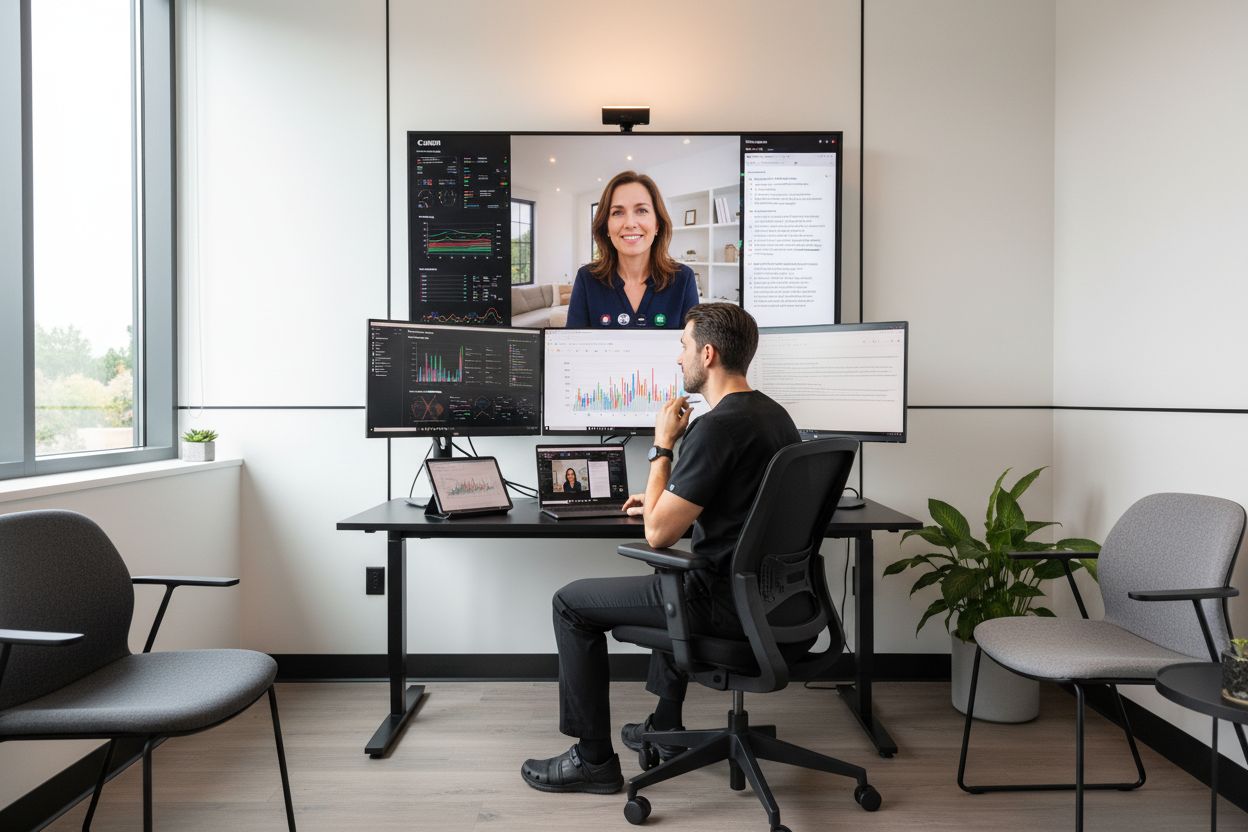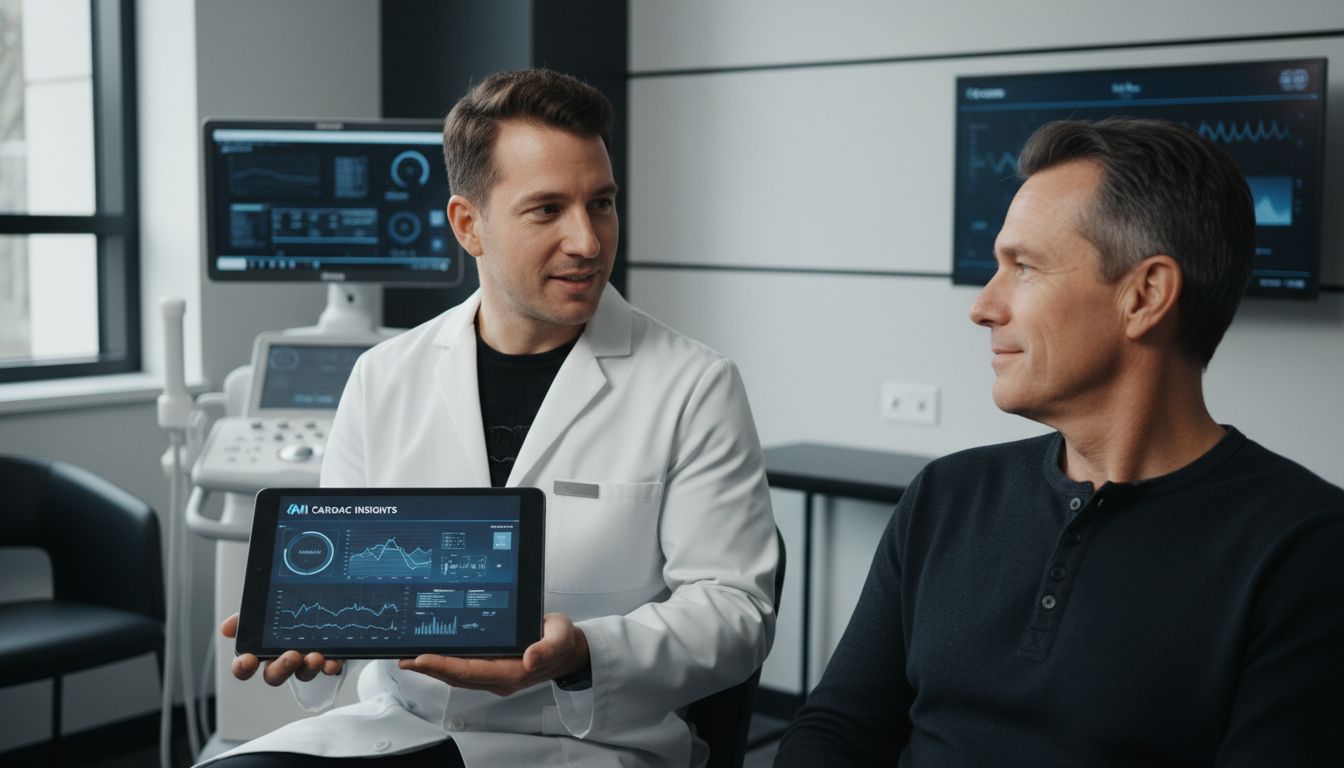Did you know that more than 80% of medical consultations can be resolved remotely thanks to artificial intelligence? AI-assisted telemedicine enables more accurate diagnoses, streamlines processes and brings quality medical care to places where it was previously unthinkable. Discovering how this technology is changing the experience for both healthcare professionals and patients can make a big difference in everyday life and the future of medicine.
Key Points
| Point | Details |
|---|---|
| AI-assisted telemedicine | It combines artificial intelligence with remote medical services, improving diagnosis, monitoring and treatment. |
| Automatic generation of clinical notes | It uses AI to transform medical consultations into structured documentation, increasing efficiency and accuracy. |
| Benefits for physicians and clinics | It reduces administrative burden, improves operational efficiency and allows more time to be spent on patient care. |
| Integration challenges | There are challenges such as algorithmic biases and lack of interoperability that require a multidisciplinary approach to overcome. |
Table of Contents
- What is ia-assisted telemedicine?
- How automatic note generation works
- Main benefits for physicians and clinics
- Telemedicine data privacy and security
- Requirements and challenges in clinical integration
What is AI-assisted telemedicine?
The AI-assisted telemedicine represents a revolution in modern healthcare, combining artificial intelligence technology with remote medical services to fundamentally transform how healthcare professionals diagnose, monitor and treat patients. More details on the transformation of healthcare with AI.
According to a recent systematic review, AI is integrated into telemedicine through advanced technologies such as machine learning, deep learning, natural language processing and computer vision. These tools enable accurate remote diagnostics, generate predictive analytics, monitor patients in real time, and provide critical support in medical decision making.
The benefits of AI-assisted telemedicine are significant:
- Accurate remote diagnosticsMedical imaging and symptom analysis with high accuracy
- Resource optimization: Reduction of waiting times and improvement of service efficiency
- Expansion of accessMedical services available even in geographically remote areas.
- Personalization of treatmentRecommendations based on individual patient data
An example of this integration is Itaca, a tool that allows clinical notes to be generated automatically during medical video calls on platforms such as Google Meet, Zoom or Microsoft Teams:
How automatic note generation works
The automatic generation of notes The use of artificial intelligence is a complex process that transforms medical queries into structured and accurate documentation. Explore our customized note templates, The documentation can be adapted to each medical specialty.
According to a recent academic study, generative language models use advanced techniques such as automatic speech recognition and natural language processing to transcribe patient-physician conversations. These systems can generate clinical notes in standardized formats such as SOAP (Subjective, Objective, Analysis, Plan) or BIRP (Behavior, Intervention, Response, Plan), significantly improving the quality and efficiency of medical documentation.

The main steps of automatic note generation include:
- Audio captureReal-time recording of the doctor-patient conversation
- TranscriptionAudio to text conversion using AI
- Semantic processingContext analysis and extraction of relevant information
- StructuringOrganization of the information in standardized clinical formats
- Review and validationFinal verification by the medical professional
Research in natural language processing applied to telemedicine shows that these systems not only automate transcription, but also structure and categorize clinical information, significantly reducing the administrative burden and minimizing possible human errors in medical documentation.

Main benefits for physicians and clinics
The automation of clinical notes artificial intelligence offers transformative benefits for healthcare professionals and their institutions. Get medical answers with accurate references, The results of this study will be used to enhance clinical decision making.
According to a recent study, automated documentation significantly reduces the administrative burden on healthcare professionals, reducing professional burnout and allowing physicians to devote more quality time to direct patient care. This optimization not only improves operational efficiency, but also positively impacts the quality of care.
The main benefits for physicians and clinics include:
The following is a comparison of the main benefits of automating clinical notes for physicians and clinics:
| Benefit | Brief description |
|---|---|
| Burnout reduction | Less administrative tasks |
| Diagnostic accuracy | Structured and consistent documentation |
| Operational efficiency | Faster and more agile processes |
| Improved communication | Clear and standardized notes |
| Better time management | More time with the patient |
- Burnout reduction: Less time spent on administrative tasks
- Diagnostic accuracyStructured and consistent documentation
- Operational efficiency: Faster and streamlined processes
- Improved communicationClear and standardized notes
- Time managementMore minutes dedicated to the patient
In addition, these AI systems enable more detailed and standardized documentation, minimizing human error, facilitating medical review and ensuring more complete and accurate clinical records, which is crucial for effective patient follow-up and continuity of care.
Telemedicine data privacy and security
The medical data privacy in telemedicine represents one of the most critical challenges of the digital transformation in healthcare. See our frequently asked questions on security to understand our information protection protocols in depth.
According to a recent research article, there is a comprehensive privacy framework that combines advanced technologies such as homomorphic encryption, blockchain, secure multiparty computing and smart contracts. These technological tools ensure confidentiality, integrity, access control and compliance with critical regulations such as HIPAA and GDPR, protecting sensitive patient information.
Fundamental security strategies include:
- End-to-end encryptionTotal protection of information
- Granular access control: Accurate permit management
- Real-time auditsContinuous transaction monitoring
- Safety certificationsCompliance with international standards
- Secure data deletionImmediate deletion protocol
From a professional perspective, the most advanced clinical documentation platforms implement proactive policies such as full encryption, rigorous security certifications, and control systems that ensure that only authorized personnel can access sensitive medical information, thus maintaining trust and integrity in telemedicine services.
Requirements and challenges in clinical integration
The telemedicine and AI integration in clinical settings presents complex challenges that go beyond simple technological implementation. Discover how to build your patients' medical records automatically to better understand these digital transformation processes.
According to a systematic review, the main challenges include algorithmic biases, data privacy limitations, regulatory gaps, lack of validation in real environments, poorly generalizable models, and interoperability problems between systems. These obstacles require a multidisciplinary approach that combines technological, ethical and regulatory aspects to ensure responsible implementation.
The fundamental requirements for successful integration include:
- Technological infrastructure: Stable and fast Internet connections
- Professional trainingDigital tools training
- Scientific validationStudies demonstrating efficacy and safety
- Cultural adaptation: Overcoming generational barriers
- Regulatory compliance: Adherence to data protection standards
A regional analysis highlights that the implementation of these technologies faces additional barriers such as geographical limitations, generational differences and a still incipient development in terms of evidence of real impact.
The key is a step-by-step approach, focused on continuous improvement and constant adaptation to the specific needs of each clinical context.
Takes Clinical Notes Automation to the Next Level with Itaca.ai
Would you like to free yourself from the exhaustion of manual documentation and transform your clinical records in just seconds? You know how difficult it is to maintain accuracy and comply with data privacy while providing efficient remote medical care. Automatic generation of clinical notes and diagnostic support through AI, concepts discussed in this article, are innovative solutions for clinics and physicians seeking efficiency and security.
Get to know the latest features that enhance your medical workflow

Don't let excessive administrative tasks limit your patient care. Try a platform designed for healthcare professionals that automates SOAP notes, integrates referenced responses and protects your patient information with the highest standard of security. Find out how Itaca.ai can help you to optimize your day-to-day life by visiting our web site. Take the step towards efficient digital medicine today.
FAQ
What is AI-assisted telemedicine?
AI-assisted telemedicine combines artificial intelligence technologies with remote medical services to improve patient diagnosis, monitoring and treatment.
How does the automatic generation of clinical notes work?
Automatic generation of clinical notes uses automatic speech recognition and natural language processing to transform doctor-patient consultations into structured and accurate documentation.
What are the main benefits of automating clinical notes?
The main benefits include reduced professional burnout, documentation accuracy, operational efficiency, improved communication and better time management with patients.
What security measures are implemented in telemedicine?
Security measures include end-to-end encryption, granular access control, real-time auditing, security certifications and secure data disposal.




Leave a Reply